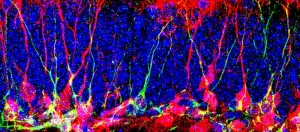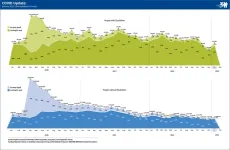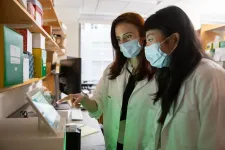(Press-News.org) Queen Mary University of London and Francis Crick Institute press release
Under strict embargo: 19:00hrs GMT Wednesday March 1, 2023
Peer reviewed
Experimental study
Cells
Vitamin B5 could help improve red blood cell production in people with Myelodysplastic syndromes
Scientists from Barts Cancer Institute at Queen Mary University of London and the Francis Crick Institute, have uncovered why patients with a rare type of blood cancer suffer from ineffective red blood cell production, and how vitamin B5 could be combined with existing drugs to improve outcomes.
Myelodysplastic syndromes (MDS) are a type of blood cancer characterised by a stem cell disorder where the production of healthy red blood cells goes wrong. There are no curative treatments for these patients, but some medications do help to slow the progression of the disease.
People with this disease often go on to develop acute myeloid leukaemia (AML) and around half of people become resistant to existing treatments for MDS within 18 months to two years of treatment. These patients are heavily reliant on red blood cell transfusions which can be painful and dangerous due to iron overload in the blood. This means it is important to uncover new ways to treat this disease and prevent the progression to leukaemia.
In their study, published in Science Translational Medicine today, the scientists analysed blood samples from 42 people with MDS. They found that the enzyme COASY is critical in regulating red blood cell production in the bone marrow. Partial loss of the enzyme in MDS patients severely disrupts red blood cell production leading to anaemia.
They then tested whether they could boost red blood cell production using treatments including vitamin B5 supplementation. Treatments with vitamin B5 or another metabolite, succinyl-CoA, increased the maturation of red blood cells.
Kevin Rouault-Pierre, Group Leader at Barts Cancer Institute and supervisor of the study, said: “Current treatments for MDS are often associated with reduced quality of life as well as the increased risk of progression to leukaemia. Understanding the biology behind this stem cell disorder is key to unlocking new treatments of the future.”
“Our next steps will be to further investigate how to boost red blood cell production and work towards testing new treatments in clinical trials.”
Syed Mian, postdoctoral research fellow in the Crick’s Haematopoietic Stem Cell Laboratory, who co-authored with Celine Philippe postdoctoral training fellow at Barts Cancer Institute, says: “Given our elderly population is increasing and age is the dominant risk factor for the development of MDS, we will start to see more and more people with this type of blood cancer.
“Anaemia-related symptoms, such as chronic fatigue, are commonly reported in MDS and the current red blood cell transfusions, although essential, come with potential complications, and also require substantial human and financial resources. Therefore, it’s essential that we find alternative ways to regulate long term red blood cell production in these patients. Our results may also potentially help with treatments of other diseases where patients commonly present with anaemia.”
-ENDS-
For further information, contact: press@crick.ac.uk or +44 (0)20 3796 5252
Notes to Editors
Reference: Mian, SA. et al. (2023). Vitamin B5 and Succinyl-CoA improve ineffective erythropoiesis in SF3B1 mutated myelodysplasia. Science Translational Medicine.
The Francis Crick Institute is a biomedical discovery institute dedicated to understanding the fundamental biology underlying health and disease. Its work is helping to understand why disease develops and to translate discoveries into new ways to prevent, diagnose and treat illnesses such as cancer, heart disease, stroke, infections, and neurodegenerative diseases.
An independent organisation, its founding partners are the Medical Research Council (MRC), Cancer Research UK, Wellcome, UCL (University College London), Imperial College London and King’s College London.
The Crick was formed in 2015, and in 2016 it moved into a brand new state-of-the-art building in central London which brings together 1500 scientists and support staff working collaboratively across disciplines, making it the biggest biomedical research facility under a single roof in Europe.
http://crick.ac.uk/
About The Barts Cancer Institute
The BCI is part of Queen Mary University of London’s Faculty of Medicine and Dentistry and one of the top five cancer research centres in the UK. Our overriding objective is to ensure that our research – which aims to identify ways to prevent cancer and develop better diagnostic techniques and treatments – is relevant to and will impact on cancer patients.
END
Vitamin B5 could help improve red blood cell production in people with Myelodysplastic syndromes
2023-03-01
ELSE PRESS RELEASES FROM THIS DATE:
How to generate new neurons in the brain
2023-03-01
Some areas of the adult brain contain quiescent, or dormant, neural stem cells that can potentially be reactivated to form new neurons. However, the transition from quiescence to proliferation is still poorly understood. A team led by scientists from the Universities of Geneva (UNIGE) and Lausanne (UNIL) has discovered the importance of cell metabolism in this process and identified how to wake up these neural stem cells and reactivate them. Biologists succeeded in increasing the number of new neurons in the brain of adult and ...
Stress gene dysregulation found in kids after injury from abuse vs. accident
2023-03-01
Epigenetic changes in the regulation of a key gene in the body’s stress response system were detected in babies and young children with abusive injuries, as opposed to accidental, according to a pilot study published in the journal Pediatric Research.
The epigenome influences levels of gene expression in response to the physical, social and emotional environment, without altering the DNA sequence. Multiple studies in adults have found that traumatic and adverse childhood experiences are associated with epigenetic alterations in the FKBP5 gene, an important regulator ...
Researchers bioengineer an endocrine pancreas for type 1 diabetes
2023-03-01
BOSTON – In people with type 1 diabetes, the body’s immune system attacks and destroys insulin-producing β cells that control blood glucose levels and are part of a group of cells in the pancreas called pancreatic islets. In research published in Cell Reports Medicine, a team led by investigators at Massachusetts General Hospital (MGH), a founding member of Mass General Brigham, recently developed an efficient way to transplant pancreatic islets and demonstrated that the method can effectively reverse type 1 diabetes in nonhuman primates.
Pancreatic islet transplantation is a promising treatment approach for type 1 diabetes; however, current methods, ...
New UCF project seeks to advance human understanding of AI reasoning
2023-03-01
ORLANDO, March 1, 2023 — A University of Central Florida researcher has received funding from the U.S. Department of Energy (DOE) to enhance the current understanding of artificial intelligence (AI) reasoning.
The project focuses on developing algorithms to create robust multi-modal explanations for foundation, or large, AI models through the exploration of several novel explainable AI methods. The DOE recently awarded $400,000 to fund the project.
The project was one of 22 proposals selected for the DOE’s 2022 Exploratory Research for Extreme-Scale Science (EXPRESS) grant, which promotes the study ...
New study reveals parents’ concerns about their sexual and gender minority teens using prep for HIV prevention
2023-03-01
Since its approval in 2012, HIV pre-exposure prophylaxis, or PrEP, has shown promise in reducing HIV infection rates by preventing infection in high-risk HIV-negative people. However, research shows that only around three percent of sexual and gender minority (SGM) adolescents who are eligible for PrEP have used it.
In a new study, Christopher Owens, PhD, assistant professor in the Department of Health Behavior at the Texas A&M University School of Public Health, explores factors that may be associated with parents’ acceptance of their SGM adolescent using PrEP. The study, published in the journal AIDS ...
New mathematical model shows promising results for prostate cancer treatment
2023-03-01
A new mathematical model which aims to optimise treatment for prostate cancer has been developed by experts at the University of Portsmouth.
Prostate cancer is the second most common cancer among men worldwide and accounts for 26 percent of all new cancer cases in males in the UK.
Over the past few decades mathematical models of tumour growth have been used to better understand the disease, to make predictions and to guide new experiments and clinical trials.
Dr Marianna Cerasuolo, Senior Lecturer from the University’s School of Mathematics and Physics, ...
nTIDE February 2023 Deeper Dive: What’s driving historic highs for employment of people with disabilities?
2023-03-01
East Hanover, NJ – March 1, 2023. In this month’s nTIDE Deeper Dive Lunch & Learn Webinar we explored the factors underlying the unprecedented rise in the employment of people with disabilities during the COVID-19 pandemic while continuing to follow trends in the labor market. This webinar followed two key unemployment indicators–the number unemployed and the proportions of unemployed persons that are on temporary layoffs (i.e., furloughs), comparing trends for people with and without disabilities.
“In January, we saw a large increase in the proportion ...
Study forecasts tile drainage and crop rotation changes for nitrogen loss
2023-03-01
URBANA, Ill. – Midwestern agriculture contributes the vast majority of nitrogen in the Gulf of Mexico, causing an oxygen-starved hypoxic zone and challenging coastal economies. State and federal policies have tried for decades to provide solutions and incentives, but the hypoxic zone keeps coming back. A recent study from the University of Illinois offers a new way to understand Midwestern nitrogen dynamics and forecasts future nitrogen loads under various management scenarios across the region.
“Our model explains what's going on across 83 watersheds in the Midwest, providing a quantitative understanding of why certain watersheds ...
Vilcek Foundation announces open call for $150,000 in prizes to immigrant scientists
2023-03-01
In 2024, the Vilcek Foundation will award three Vilcek Prizes for Creative Promise in Biomedical Science of $50,000 each. The prizes recognize and celebrate the contributions of rising immigrant scientists in the United States whose work represents a significant contribution to their field. The Vilcek Foundation is hosting an open call for applications for the 2024 prizes; applications will be accepted through June 12, 2023, at 5:00 p.m. ET.
The Vilcek Prizes for Creative Promise are a part of the Vilcek Foundation Prizes program. Awarded ...
Through the eye of the beholder: Researchers find people with autism process illusory shapes differently
2023-03-01
There is this picture – you may have seen it. It is black and white and has two silhouettes facing one another. Or maybe you see the black vase with a white background. But now, you likely see both.
It is an example of a visual illusion that reminds us to consider what we did not see at first glance, what we may not be able to see, or what our experience has taught us to know – there is always more to the picture or maybe even a different image to consider altogether. Researchers are finding the process in our brain that allows us to see these visual distinctions may ...


